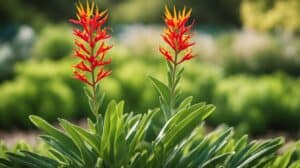Indoor palm trees are a great way to add a touch of tropical elegance to any home or office.
The Areca and Majesty palms are two of the most popular choices for novice indoor gardeners.
These palms are relatively easy to care for and can thrive in a variety of indoor environments.

The Areca palm, also known as the Butterfly palm, is a graceful and delicate plant that can add a touch of exotic beauty to any room.
With its feathery fronds and slender stems, the Areca palm is a great choice for those who want to create a lush, tropical atmosphere.
It is also one of the easiest indoor palm trees to care for, making it a great choice for novice gardeners.
The Majesty palm, on the other hand, is a more majestic and regal plant that can add a touch of grandeur to any indoor space.
With its tall, slender trunk and lush green fronds, the Majesty palm is a great choice for those who want to create a statement piece in their home or office.
While it requires a bit more care than the Areca palm, the Majesty palm is still a relatively easy plant to care for and can thrive in a variety of indoor environments.
Selecting the Right Palm Tree
When choosing a palm tree for your indoor space, it is important to consider the specific needs and characteristics of the plant.
Here are some things to keep in mind when selecting the right palm tree:
Areca Palm Overview
The Areca Palm is a popular choice for indoor palm trees due to its graceful appearance and ease of care.
It is also known as the Butterfly Palm due to its fronds resembling butterfly wings.
This palm tree can grow up to 6-7 feet tall and requires bright, indirect light.
It prefers well-draining soil and should be watered when the top inch of soil feels dry to the touch.
The Areca Palm is non-toxic to pets, making it a great option for pet owners.
Majesty Palm Characteristics
The Majesty Palm is another popular choice for indoor palm trees due to its majestic appearance and tropical vibe.
It can grow up to 10-12 feet tall and requires bright, indirect light.
It prefers well-draining soil and should be watered when the top inch of soil feels dry to the touch.
The Majesty Palm is toxic to pets, so it may not be the best option for pet owners.
When selecting the right palm tree, it is important to consider the space available, lighting conditions, and any potential hazards for pets.
By keeping these factors in mind, you can choose the perfect palm tree to add a touch of tropical elegance to your indoor space.
Caring for Your Indoor Palm Tree

Indoor palm trees are a great way to add a touch of tropical beauty to any living space.
However, keeping them healthy and thriving can be a bit of a challenge. Here are some tips on how to care for your indoor palm tree:
Optimal Lighting Conditions
Palm trees thrive in bright, indirect light. Direct sunlight can scorch the leaves, while too little light can cause the leaves to turn yellow and drop off.
If your palm tree isn’t getting enough light, consider moving it closer to a window or adding artificial lighting.
Watering and Humidity Needs
Palm trees prefer consistently moist soil, but they don’t like to be overwatered. Allow the top inch of soil to dry out before watering again.
It’s also important to maintain a level of humidity around the plant.
You can achieve this by misting the leaves regularly or placing a humidifier nearby.
Soil and Fertilization Tips
Palm trees require well-draining soil that’s rich in organic matter. Avoid using heavy soils that retain moisture, as they can lead to root rot.
Fertilize your palm tree every two to three months during the growing season with a balanced fertilizer.
Temperature and Placement
Palm trees prefer warm temperatures between 65-85°F (18-29°C). Keep your palm tree away from cold drafts and air conditioning vents.
Also, make sure to rotate the plant occasionally, so all sides receive equal light exposure.
By following these simple tips, you can keep your indoor palm tree healthy and beautiful for years to come.
Common Challenges and Solutions

Pest Prevention and Treatment
Indoor palm trees are susceptible to pests like spider mites, mealybugs, and scale insects. These pests can cause damage to the leaves and weaken the plant.
To prevent infestations, it’s important to keep the palm tree clean and dust-free.
Wiping the leaves with a damp cloth can help remove any dust or debris that may attract pests.
If an infestation does occur, there are several treatment options available.
One option is to use an insecticidal soap or oil, which can be applied directly to the affected areas.
Another option is to introduce natural predators like ladybugs or lacewings to the environment, which can help control the pest population.
Addressing Yellowing Leaves
Yellowing leaves are a common issue with indoor palm trees and can be caused by several factors, including overwatering, underwatering, or lack of sunlight.
To address yellowing leaves, it’s important to identify the root cause of the issue.
If the palm tree is overwatered, it may be necessary to adjust the watering schedule or improve drainage.
If the palm tree is underwatered, it may be necessary to increase the frequency of watering or adjust the amount of water given.
If the palm tree is not receiving enough sunlight, it may be necessary to move it to a brighter location or supplement with artificial light.
Overcoming Root Rot
Root rot is a fungal disease that can occur in indoor palm trees when the soil remains too wet for extended periods of time.
Symptoms of root rot include yellowing leaves, wilting, and stunted growth.
To overcome root rot, it’s important to identify the issue early and take action quickly.
One solution is to repot the palm tree in fresh, well-draining soil.
It’s also important to adjust the watering schedule to prevent the soil from becoming too wet.
In severe cases, it may be necessary to remove the affected roots and treat the remaining healthy roots with a fungicide.
Pruning and Maintenance

Pruning Techniques
Regular pruning is essential to keep palm trees healthy and looking their best.
Pruning helps remove dead or damaged fronds, promote new growth, and prevent the spread of diseases.
The Areca and Majesty palms are relatively low-maintenance and easy to prune.
To prune the fronds, use sharp pruning shears or a saw. Cut the frond at the base, leaving about an inch of the stem attached to the trunk.
Avoid cutting too close to the trunk, as this can damage the tree.
It’s best to prune only the yellow or brown fronds, as the green ones are still producing food for the tree.
When pruning, be careful not to damage the growing tip, which is the small bud at the top of the trunk.
This bud is responsible for producing new fronds, and damaging it can stunt the tree’s growth.
Cleaning and Dusting
Keeping the palm tree clean is also important for its health and appearance.
Dust and debris can accumulate on the fronds, blocking sunlight and inhibiting the tree’s ability to photosynthesize.
To clean the fronds, use a soft cloth or sponge dipped in a solution of mild soap and water. Wipe the fronds gently, taking care not to bend or break them.
Rinse the fronds with clean water and allow them to air dry.
In addition to regular cleaning, it’s a good idea to inspect the palm tree for pests and diseases.
Look for signs of spider mites, mealybugs, or scale insects, which can damage the tree and spread to other plants.
If you notice any signs of infestation, treat the tree with an appropriate insecticide or fungicide.
By following these simple pruning and maintenance tips, novices can keep their Areca and Majesty palms healthy and beautiful for years to come.
Frequently Asked Questions

How do you care for a Majesty Palm indoors?
Majesty Palms are relatively easy to care for indoors. They require bright, indirect light and moist soil.
It is important to not let the soil dry out completely, but also not to overwater.
Majesty Palms also benefit from occasional misting to increase humidity levels.
Fertilizing once a month during the growing season can also help keep the plant healthy.
What are the benefits of having a Majesty Palm inside your home?
Majesty Palms are known for their beautiful, tropical appearance and can add a touch of elegance to any indoor space.
They also have air-purifying qualities, helping to remove toxins from the air.
Can Areca Palms thrive in an indoor environment?
Yes, Areca Palms can thrive indoors with proper care. They require bright, indirect light and well-draining soil.
They also benefit from occasional misting to increase humidity levels.
Fertilizing once a month during the growing season can also help keep the plant healthy.
What is the best way to care for palm plants inside the house?
The best way to care for palm plants indoors is to provide them with adequate light, water, and humidity.
They require bright, indirect light and moist soil, but not too much water. It is important to not let the soil dry out completely, but also not to overwater.
Misting the leaves occasionally can help increase humidity levels. Fertilizing once a month during the growing season can also help keep the plant healthy.
What common issues should a novice expect with indoor Majesty Palms?
Novices may experience issues with overwatering or underwatering their Majesty Palms.
It is important to find a balance between the two and to not let the soil dry out completely or become waterlogged.
Majesty Palms may also be susceptible to spider mites and mealybugs, which can be treated with insecticidal soap.
Are there any key differences between Majesty Palms and Areca Palms?
Yes, there are some key differences between Majesty Palms and Areca Palms.
Majesty Palms have larger, more frond-like leaves, while Areca Palms have thinner, more feathery leaves.
Majesty Palms also require more moisture than Areca Palms, but both require bright, indirect light and well-draining soil.














